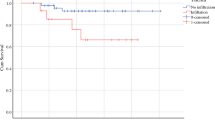Abstract
Objectives
We sought to validate the feasibility of preserving a functioning recurrent laryngeal nerve (RLN) invaded by papillary thyroid carcinoma (PTC) using a shaving technique followed by high-dose radioactive iodine (RAI) therapy.
Methods
A retrospective review of 34 patients with locally invasive PTC who had exclusive tumor involvement of a functioning RLN was performed. All patients underwent total thyroidectomy and high-dose RAI therapy. A shaving technique was conducted with the goal of leaving the smallest amount of residual tumor as possible while attempting to preserve nerve function. Clinicopathologic factors and oncologic outcomes of the patients with resected RLN (group A, n = 14) and preserved RLN (group B, n = 20) were compared.
Results
The two groups showed no differences in clinicopathologic factors or follow-up period. Mean dose of radioiodine therapy was 245.0 ± 140.3 mCi (range 100–540 mCi). Permanent postoperative vocal cord paralysis after RLN shaving occurred in two patients of group B (10 %). Only one patient (5 %) in group B had local recurrence at the thyroid bed where the residual tumor was located. The overall recurrence rate was 35.7 % (5/14) and 20.0 % (4/20) in groups A and B, respectively showing no significant difference (p = 0.525). There were no cases of death due to PTC during the median follow-up of 75 months (range 36–159 months).
Conclusions
Patients with locally invasive PTC with exclusive involvement of a functioning RLN may be treated by nerve shaving followed by treatment of the macroscopic residual tumor with high-dose RAI therapy.



Similar content being viewed by others
References
Davies L, Welch HG (2006) Increasing incidence of thyroid cancer in the United States, 1973–2002. JAMA 295:2164–2167
Shindo ML, Caruana S, Kandil E et al (2014) Management of invasive well-differentiated thyroid cancer an American Head and Neck society consensus statement. Head Neck 36:1379–1390
McCaffrey JC (2006) Aerodigestive tract invasion by well differentiated thyroid carcinoma: diagnosis, management, prognosis, and biology. Laryngoscope 116:1–11
Chan WF, Lo CY, Lam KY et al (2004) Recurrent laryngeal nerve palsy in well-differentiated thyroid carcinoma: clinicopathologic features and outcome study. World J Surg 28:1093–1098. doi:10.1007/s00268-004-7419-z
McCaffrey TV, Bergstralh EJ, Hay ID (1994) Locally invasive papillary thyroid carcinoma: 1940–1990. Head Neck 16:165–172
Falk SA, McCaffrey TV (1995) Management of the recurrent laryngeal nerve in suspected and proven thyroid cancer. Otolaryngol Head Neck Surg 113:42–48
Nishida T, Nakao K, Hamaji M et al (1997) Preservation of recurrent laryngeal nerve invaded by differentiated thyroid cancer. Ann Surg 226:85–91
Lang BH-H, Lo C-Y, Wong KP et al (2013) Should an involved but functioning recurrent laryngeal nerve be shaved or resected in a locally advanced papillary thyroid carcinoma? Ann Surg Oncol 20:2951–2957
Ito Y, Tomoda C, Uruno T et al (2006) Prognostic significance of extrathyroid extension of papillary thyroid carcinoma: massive but not minimal extension affects the relapse-free survival. World J Surg 30:780–786. doi:10.1007/s00268-005-0270-z
Tuttle RM, Rondeau G, Lee NY (2011) A risk-adapted approach to the use of radioactive iodine and external beam radiation in the treatment of well-differentiated thyroid cancer. Cancer Control 18:89–95
Kihara M, Miyauchi A, Yabuta T et al (2014) Outcome of vocal cord function after partial layer resection of the recurrent laryngeal nerve in patients with invasive papillary thyroid cancer. Surgery 155:184–189
Acknowledgments
This study was supported by a Grant from Kosin University College of Medicine, Busan, Republic of Korea.
Conflict of interest
The authors declare no conflicts of interest or financial relationships to disclose.
Author information
Authors and Affiliations
Corresponding author
Rights and permissions
About this article
Cite this article
Lee, H.S., Kim, S.W., Park, T. et al. Papillary Thyroid Carcinoma with Exclusive Involvement of a Functioning Recurrent Laryngeal Nerve May Be Treated with Shaving Technique. World J Surg 39, 969–974 (2015). https://doi.org/10.1007/s00268-014-2906-3
Published:
Issue Date:
DOI: https://doi.org/10.1007/s00268-014-2906-3




